|
|
| Spot |
| Yae Shrine | 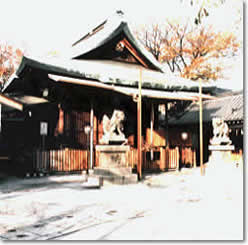 |
| Location: 3-16-22 Momodani, Ikuno-ku | |
| Access: 10 minutes walk to the northeast from JR Momodani Station | |
| According to old chronicles, the Yae
Shrine was founded in the late 16th century with Susanoono Mikoto
(brother of the Sun Goddess Amaterasu) invited from the Kumanofu Shrine
in Izumo province as chief deity. Since its foundation the shrine was known as Gozu Tenno, until 1872 when it was renamed Yae following the Shinto reformation after the Meiji Restoration. The shrine has been revered by the villagers of Kono (at present Momodani) for its tutelary deity. In 1910, the parishioners decided to invite the tutelary deity of the Mitate Shrine in the Okamura district (at present 4-chome Katsuyama) and to enshrine that god (called the "God of Thorns") together with Susanoono Mikoto. The Mitate Shrine is said to have been a palace of Emperor Nintoku in the 4th century. At present the Mitate Shrine is a temporary edifice for the gods of Yae at festivals. |
| Miyukimori Tenjin Shrine | 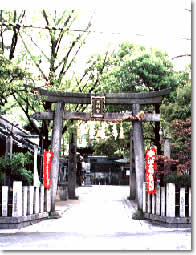 |
| Location: 3-10-5 Momodani, Ikuno-ku | |
| Access: 10 minutes walk to the east from JR Momodani Station | |
| The deities of this shrine
are Emperor Nintoku, Sukunahikono Mikoto and Osakahikono Mikoto. In
the Edo period, the shrine was called Miyukino Miya or Tenno Tenjinsha. On the stone monument at the gate is engraved the history of the shrine. In the 4th century, Emperor Nintoku hunted with a falcon on a small hill here, which was in the northern part of Kudarano (as Osaka Plain was previously known); hence the name of Miyukimori (forest of imperial visit). In the precincts are five old muku trees (Aphananthe aspera), which are conserved by the Osaka City authorities as part of nature preservation efforts. |
| Ikuno Shrine | 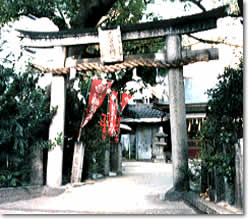 |
| Location: 1-2-27 Sharidera, Ikuno-ku | |
| Access: 5 minutes walk to the west from the bus station Ikuno Fire Station | |
| This shrine had been known as Gozu Tennogu
until 1909 when it was renamed the Shrine of Susanoono Mikoto. The
name was again changed to the present Ikuno Shrine in 1947. The heraldic
emblem of the shrine is the mokko (playcrater arguta). The torii (shrine
gate) in the picture is smaller than usual. According to the inscription,
it was built in the 7th year of Hoei (1711), being the oldest torii
in Ikuno-ku. Beside the torii stands a taller stone monument. Hackberry
and ginkgo trees overhang the torii. The pair of stone guardian dogs in front of the hall of worship was erected here in 1834. In those days pilgrimage to the Grand Shrine of Ise and worship of the Shinto gods were prevalent, and these dog figures were dedicated by the villagers to the tutelary deity. |
| Ikuno Yasaka Shrine | 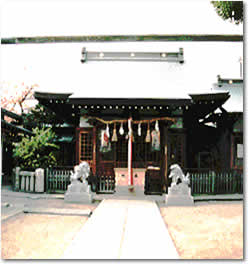 |
| Location: 4-7-11 Ikuno-Higashi, Ikuno-ku | |
| Access: Bus station Ikuno Yasaka Shrine | |
| According to old chronicles,
this shrine may have been built in 1689 as the Susanoono Mikoto Shrine,
although there are other opinions about the date of its erection.
The shrine was the village shrine of Hayashidera Village, Higashigoori (the old name of this area) until 1908 when it was made a branch shrine of the Kawabori Ino Shrine in Tennoji-ku. In 1955, Hayashidera villagers restored the shrine as the Ikuno Yasaka Shrine. Since then it has attracted many worshippers as "Gion-sama (another name of Susanoono Mikoto) in Ikuno." |
| Tajima Shrine | 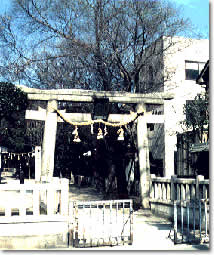 |
| Location: 3-5-34 Tajima, Ikuno-ku | |
| Access: 3 minutes walk to the east from the bus station Tajima 3 | |
| Although the history of
this shrine was lost in floods, inscriptions on its stone lanterns
show that it was erected before 1684. The shrine was originally known as Tenmangu, with Sugawarano Ookami as chief deity and Kotoshironushino Mikoto and Hachiman (God of War) as secondary deities. In 1793 the shrine was renamed Tenjinsha with Sukunahikono Mikoto as chief deity. In 1909 its name was changed, becoming the present Tajima Shrine. In 1989 the main shrine was rebuilt and the stone torii and the cow figure attendant on Tenjin (Sugawarano Okami) were erected in commemoration of the present Emperor's accession. |